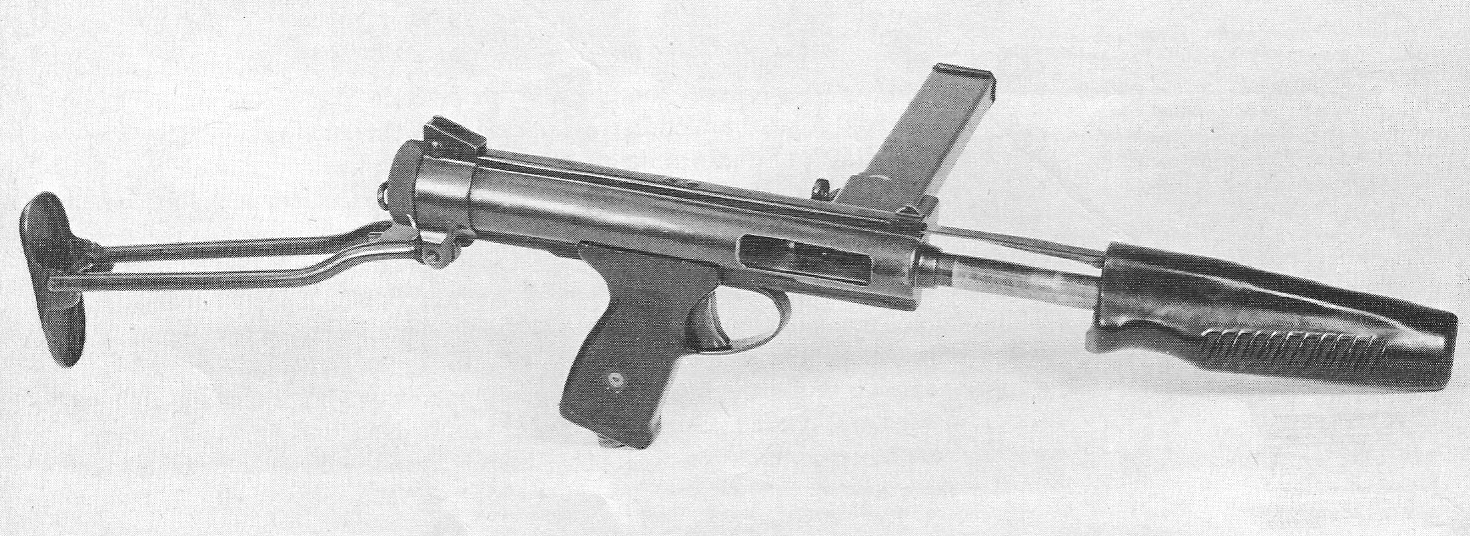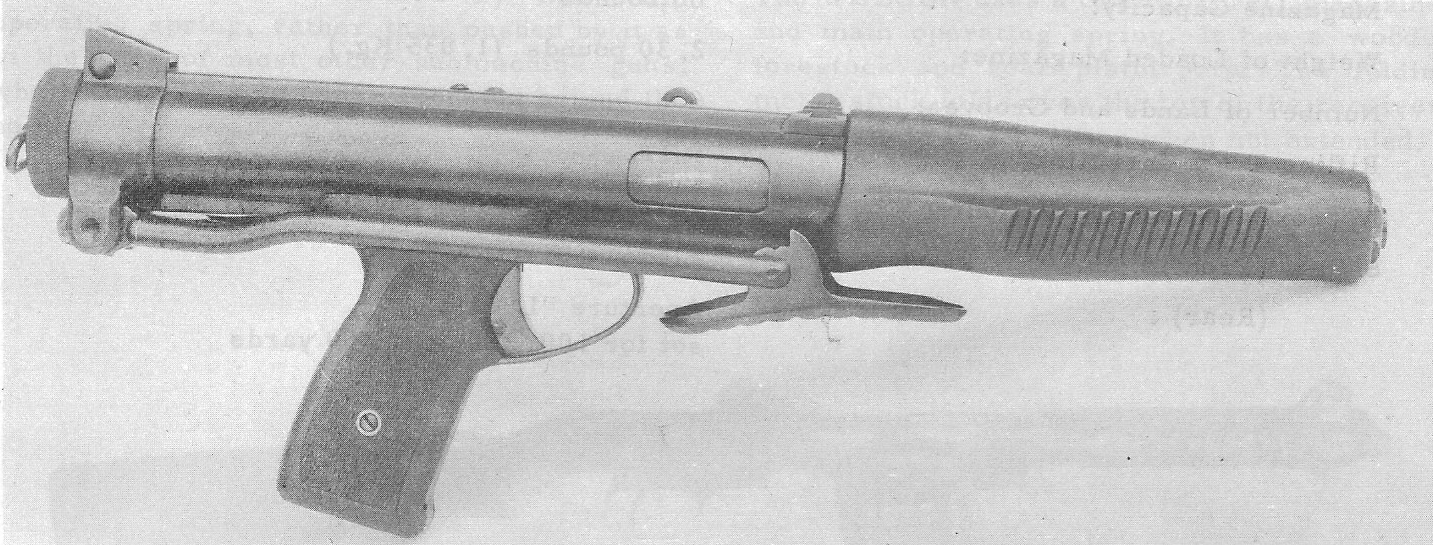On the 12th of April 1945 a new submachine
gun from Birmingham Small Arms was demonstrated at Enfield. This gun -
designed by Claude A. Perry and Roger D. Wackrow - was proposed to the
Ordnance Board as a post-war replacement for the stop-gap Sten gun, which
was beginning to overstay its welcome in British service. It operated on
an unusual cocking action, in which there was no cocking slot but instead
the user would twist the fore-end before pushing it forward and then
pulling it back, in a slide-action fashion. This pushed the bolt into the
open position and from there the bolt would move independently of the
fore-end. BSA also took a feature commonly seen on French and Italian SMGs
of the period, but very rarely on British designs - the magazine housing
was built on a hinge so that it could fold across the length of the
receiver when not in use. This was designed for compact carry, as
side-feeding SMGs could be uncomfortable to wear on a sling due to the
horizontal magazine jutting into the user's sides or back. By standard,
this Mk.I BSA fed from 32-round Sten magazines, but a .30-caliber version
was also developed.
Four prototypes of this BSA submachine gun were shown at Enfield, and the
Ordnance Board considered that the design could be a contender to replace
the Sten gun in post-war service. They arranged further tests of the gun
all throughout the month of October 1945, during which any major faults
would have been exposed. The Ordnance Board found nothing to stop the gun
from advancing to troop trials - their only major criticism was the weight
of the gun, which exceeded their specifications - and the BSA was added to
a shortlist of SMGs that showed promise, including the BSA's main rival,
the Patchett gun.
 The bolt and return spring of the early
prototype BSA Mk.I machine carbine.
The bolt and return spring of the early
prototype BSA Mk.I machine carbine.
It was not until June 1947 that the Ordnance Board arranged further
trials. This time the BSA was tried against the new submachine gun from
RSAF Enfield, the MCEM-3. By now the BSA design had been modified with a
new curved 30-round magazine and a cylindrical cocking sleeve. The hinged
magazine housing was retained but no longer lay flat against the receiver
due to the shape of the magazine. In the June tests, the BSA came out
overall better than the MCEM-3, but criticisms were still directed at the
BSA's weight.
The BSA Mk.II was tested in comparative trials against the MCEM-3,
Patchett, and Australian MCEM-1, from the 8th to the 16th of September
1947. The trials took place at Pendine. None of the weapons came out
particularly well and all were sent back for improvements. While the
MCEM-1 was sent back to Australia for redevelopment, the BSA, Patchett,
and MCEM-3 were tried again in April 1948. The BSA came out the best and
both it and the Patchett were forwarded for troop trials, whereas the
MCEM-3 was not considered worth developing any further. By this point some
of the examining officers were so convinced of the BSA's superiority over
the Patchett that they recommended its adoption. The Ordnance Board placed
an order for some 100 trial samples from BSA but when the projected costs
of this order came back from BSA, the order was substantially reduced to
only 6 guns.
 Later BSA Mk.II with redesigned
fore-end.
Later BSA Mk.II with redesigned
fore-end.
When the 6 guns - built in an improved Mk.II pattern - were delivered to
the Ordnance Board in October 1949, they were briefly tested but were
quickly sent back to BSA for improvements to the triggers. Meanwhile the
General Staff released a new criteria for submachine guns which demanded
compatibility with a bayonet. The Mk.II-pattern BSA could not take a
bayonet due to the shape of the cocking sleeve, so it had to be taken back
to the drawing board for an overhaul. The new model came about in the
early 1950s and featured an entirely new fore-end shape with a protruding
muzzle onto which the No.9 spike bayonet could be fitted. This was known
as the BSA Mk.III, and represented the final iteration of the gun.
The new Mk.III BSA was tested in May 1951 against the Patchett Mk.II, the
Australian MCEM-2 from Lithgow Arsenal, and the Madsen Model 50 from
Denmark. The Australian gun was defective and provided little competition,
but the BSA could not compete with the Patchett and Madsen guns.
Particularly, the BSA's new fore-end came under scrutiny for being stiffer
and harder to cock than the previous iterations. In addition, the both the
Madsen and Patchett guns were lighter, easier to strip, and overall gave
better reliability and endurance than the BSA. The BSA, in fact, could not
be field-stripped without a special set of tools provided with the gun.
And where the Patchett's trigger had been improved substantially, the
BSA's gave trouble throughout the tests.
 The final Mk.III iteration with No.9
bayonet. The magazine housing is fixed.
The final Mk.III iteration with No.9
bayonet. The magazine housing is fixed.
BSA were very unsatisfied with the result, and considered that the change
in the General Staff specifications had hindered their efforts. They
voiced their complaints to the Ordnance Board, who agreed to hold a
retrial in 1952, after the decision to adopt the Patchett had basically
already gone ahead. The Patchett and BSA were tested against an improved
version of the Madsen gun, which performed excellently and was almost
considered for adoption. The BSA once again failed to impress and was
rejected. With no domestic military interest, BSA ceased development of
the design.
Gallery
(click to enlarge)












